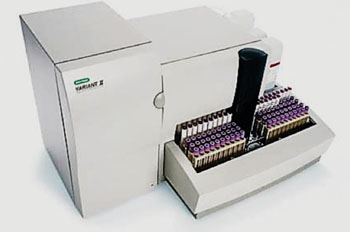Prediabetes Linked to Early Kidney Damage
By LabMedica International staff writers
Posted on 10 Jan 2016
The role of prediabetes as a risk factor for hyperfiltration and albuminuria in persons who do not develop diabetes is unclear and the lack of evidence is mainly due to the difficulty of accurately assessing the glomerular filtration rate (GFR) in the near-normal range of GFR. Posted on 10 Jan 2016
Diabetes is a major risk factor for kidney disease with around 30% of people with type 1 diabetes and 10%–40% of those with type 2 diabetes will go on to experience kidney failure. New findings suggest that even before a diabetes diagnosis, higher-than-normal blood sugar levels could be causing kidney damage.

Image: The fully automated VARIANTII Hemoglobin Testing System (Photo courtesy of Bio-Rad).
Scientists at the University Hospital of North Norway (Tromso, Norway) and their colleagues studied a sample of 1,627 persons aged 50 to 62 years from the general population without self-reported kidney disease, myocardial infarction, stroke, or diabetes. GFR was measured at baseline and follow-up using single-sample plasma iohexol clearance. Serum iohexol was measured by high-performance liquid chromatography.
Serum creatinine analyses were performed using a standardized enzymatic assay, and cystatin C was measured by particle-enhanced turbidimetric immunoassay. GFR was estimated from creatinine or cystatin C levels. Urinary albumin and urinary creatinine excretion were measured with commercial kits. The albumin-creatinine ratio (ACR) was calculated in milligrams per millimole for each urine specimen, and the mean ACR was used in the analyses. HbA1c was measured using liquid chromatography (Variant II instrument; Bio-Rad Laboratories; Hercules CA, USA), and fasting serum glucose was measured on the Modular model P800 (Roche Diagnostics; Basel, Switzerland). Insulin samples were measured with an enzyme-linked immunosorbent assay kit.
In the study, prediabetes was classed as an fasting glucose (FG) level of 110-125 mg/dL (6.1-6.9 mmol/L) and/or a HbA1c level of 6%–6.4%,. The presence of prediabetes among study participants was assessed at study baseline, and subjects were followed-up for a median of 5.6 years. At study baseline, 595 of the participants had prediabetes. After adjusting for participants' lifestyle and use of medications, the scientists found those with prediabetes had a higher measured GFR (mGFR) during follow-up than those without prediabetes, which is a sign of hyperfiltration in the kidneys. The team also found that high FG levels at baseline among these subjects were associated with high levels of the protein albumin in the urine during follow-up, an early sign of kidney disease.
Toralf Melsom, MD, PhD, the lead author of the study said, “Our study shows that the pathological process of kidney injury caused by elevated blood glucose levels starts in prediabetes, well before the onset of diabetes. Prediabetes may be a target for early intervention to prevent chronic kidney disease (CKD) caused by hyperglycemia. If a patient has borderline elevated glucose levels found by their primary physician they should start lifestyle changes with respect to diet and physical activity to preventing diseases like diabetes and kidney disease.” The study was published on December 29, 2015, in the American Journal of Kidney Disease.
Related Links:
University Hospital of North Norway
Bio-Rad Laboratories
Roche Diagnostics














